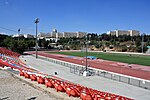Puchar Azji w Piłce Nożnej 1964
| |||
| Dyscyplina | |||
|---|---|---|---|
| Organizator | |||
| Szczegóły turnieju | |||
| Gospodarz | |||
| Otwarcie | |||
| Zamknięcie (finał) | |||
| Liczba drużyn | 4 (z 1 konfederacji) | ||
| Liczba aren | 4 (w 4 miastach) | ||
| I miejsce | |||
| II miejsce | |||
| III miejsce | |||
| Statystyki turnieju | |||
| Liczba meczów | 6 | ||
| Liczba bramek | 13 (2,17 na mecz) | ||
| Oglądalność | 99 000 (16 500 na mecz) | ||
| Król strzelców |
| ||
Puchar Azji 1964 odbył się w maju 1964 roku w Izraelu.
Stadiony
Turniej finałowy rozegrany został na czterech obiektach:
| Ramat Gan | Hajfa | Tel Awiw-Jafa | Jerozolima |
|---|---|---|---|
| Stadion Ramat Gan | Kiryat Eliezer Stadium | Stadion Bloomfield | Stadion Uniwersytetu Hebrajskiego |
| Pojemność: 41,583 | Pojemność: 14,002 | Pojemność: 17,500 | Pojemność: 10,000 |
 |  |
Eliminacje
 Izrael miał zapewniony awans jako gospodarz turnieju.
Izrael miał zapewniony awans jako gospodarz turnieju. Korea Płd. miała zapewniony awans jako obrońca tytułu.
Korea Płd. miała zapewniony awans jako obrońca tytułu. Indie zakwalifikowały się bez gry (początkowo miała grać z
Indie zakwalifikowały się bez gry (początkowo miała grać z  Iranem,
Iranem,  Pakistanem i kilkoma innymi drużynami, jednak te nie chciały grać w tym kraju z powodów politycznych. W ten sposób Indie dostały automatycznie wolne miejsce w turnieju).
Pakistanem i kilkoma innymi drużynami, jednak te nie chciały grać w tym kraju z powodów politycznych. W ten sposób Indie dostały automatycznie wolne miejsce w turnieju).
Grupa 1 (mecze w Wietnamie Południowym)
| Lp. | Zespół | Mecze | Z | R | P | Bramki | Pkt. |
|---|---|---|---|---|---|---|---|
| 1 | 3 | 2 | 1 | 0 | 11:7 | 5 | |
| 2 | 3 | 2 | 0 | 1 | 9:7 | 4 | |
| 3 | 3 | 1 | 0 | 2 | 9:10 | 2 | |
| 4 | 3 | 0 | 1 | 2 | 4:9 | 1 |
7 grudnia 1963 ![]() Hongkong 3-3
Hongkong 3-3 ![]() Tajlandia
Tajlandia
7 grudnia 1963 ![]() Wietnam Południowy 5-3
Wietnam Południowy 5-3 ![]() Malezja
Malezja
11 grudnia 1963 ![]() Malezja 3-1
Malezja 3-1 ![]() Tajlandia
Tajlandia
11 grudnia 1963 ![]() Wietnam Południowy 1-4
Wietnam Południowy 1-4 ![]() Hongkong
Hongkong
14 grudnia 1963 ![]() Hongkong 4-3
Hongkong 4-3 ![]() Malezja
Malezja
14 grudnia 1963 ![]() Wietnam Południowy 3-0
Wietnam Południowy 3-0 ![]() Tajlandia
Tajlandia
Turniej finałowy
| Lp. | Zespół | Mecze | Z | R | P | Bramki | Pkt. |
|---|---|---|---|---|---|---|---|
| 1 | 3 | 3 | 0 | 0 | 5:1 | 6 | |
| 2 | 3 | 2 | 0 | 1 | 5:3 | 4 | |
| 3 | 3 | 1 | 0 | 2 | 2:4 | 2 | |
| 4 | 3 | 0 | 0 | 3 | 1:5 | 0 |
| Korea Płd. | 0 – 2 | ||
| Hongkong | 0 – 1 | ||
| Indie | 0 – 2 | ||
| Korea Płd. | 1 – 0 | ||
| Indie | 3 – 1 | ||
| Korea Płd. | 1 – 2 |
Linki zewnętrzne
Media użyte na tej stronie
Pictograms of Olympic sports - Football. This is unofficial sample picture. Images of official Olympic pictograms for 1948 Summer Olympics and all Summer Olympics since 1964 can be found in corresponding Official Reports.
Autor: https://phabricator.wikimedia.org/diffusion/GOJU/browse/master/AUTHORS.txt, Licencja: MIT
A icon from the OOjs UI lib.
Autor: https://phabricator.wikimedia.org/diffusion/GOJU/browse/master/AUTHORS.txt, Licencja: MIT
A icon from the OOjs UI lib.
Flag of Israel. Shows a Magen David (“Shield of David”) between two stripes. The Shield of David is a traditional Jewish symbol. The stripes symbolize a Jewish prayer shawl (tallit).
The Flag of India. The colours are saffron, white and green. The navy blue wheel in the center of the flag has a diameter approximately the width of the white band and is called Ashoka's Dharma Chakra, with 24 spokes (after Ashoka, the Great). Each spoke depicts one hour of the day, portraying the prevalence of righteousness all 24 hours of it.
The national flag of Kingdom of Thailand since September 2017; there are total of 3 colours:
- Red represents the blood spilt to protect Thailand’s independence and often more simply described as representing the nation.
- White represents the religion of Buddhism, the predominant religion of the nation
- Blue represents the monarchy of the nation, which is recognised as the centre of Thai hearts.
Flaga Wietnamu Południowego
Maccabi Tel Aviv vs Beitar Jerusalem, Bloomfield Stadium
(c) NYC2TLV at the English Wikipedia, CC-BY-SA-3.0
View from atop the stands of Ramat Gan Stadium before a World Cup 2006 qualifier between France and Israel.















